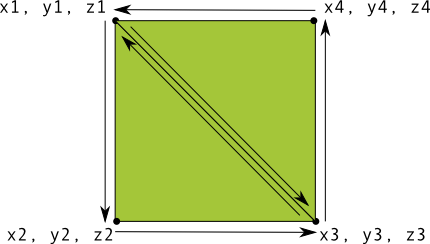定義形狀
編寫:jdneo - 原文:http://developer.android.com/training/graphics/opengl/shapes.html
在一個OpenGL ES View的上下文(Context)中定義形狀,是創建你的傑作所需要的第一步。在瞭解關於OpenGL ES如何定義圖形對象的基本知識之前,通過OpenGL ES 繪圖可能會有些困難。
這節課將講解OpenGL ES相對於Android設備屏幕的座標系,定義形狀和形狀表面的基本知識,如定義一個三角形和一個矩形。
定義一個三角形
OpenGL ES允許我們使用三維空間的座標來定義繪畫對象。所以在我們能畫三角形之前,必須先定義它的座標。在OpenGL 中,典型的辦法是為座標定義一個浮點型的頂點數組。為了高效起見,我們可以將座標寫入一個ByteBuffer,它將會傳入OpenGl ES的圖形處理流程中:
public class Triangle {
private FloatBuffer vertexBuffer;
// number of coordinates per vertex in this array
static final int COORDS_PER_VERTEX = 3;
static float triangleCoords[] = { // in counterclockwise order:
0.0f, 0.622008459f, 0.0f, // top
-0.5f, -0.311004243f, 0.0f, // bottom left
0.5f, -0.311004243f, 0.0f // bottom right
};
// Set color with red, green, blue and alpha (opacity) values
float color[] = { 0.63671875f, 0.76953125f, 0.22265625f, 1.0f };
public Triangle() {
// initialize vertex byte buffer for shape coordinates
ByteBuffer bb = ByteBuffer.allocateDirect(
// (number of coordinate values * 4 bytes per float)
triangleCoords.length * 4);
// use the device hardware's native byte order
bb.order(ByteOrder.nativeOrder());
// create a floating point buffer from the ByteBuffer
vertexBuffer = bb.asFloatBuffer();
// add the coordinates to the FloatBuffer
vertexBuffer.put(triangleCoords);
// set the buffer to read the first coordinate
vertexBuffer.position(0);
}
}
默認情況下,OpenGL ES會假定一個座標系,在這個座標系中,[0, 0, 0](分別對應X軸座標, Y軸座標, Z軸座標)對應的是GLSurfaceView的中心。[1, 1, 0]對應的是右上角,[-1, -1, 0]對應的則是左下角。如果想要看此座標系的插圖說明,可以閱讀OpenGL ES開發手冊。
注意到這個形狀的座標是以逆時針順序定義的。繪製的順序非常關鍵,因為它定義了哪一面是形狀的正面(希望繪製的一面),以及背面(使用OpenGL ES的Cull Face功能可以讓背面不要繪製)。更多關於該方面的信息,可以閱讀OpenGL ES開發手冊。
定義一個矩形
在OpenGL中定義三角形非常簡單,那麼你是否想要來點更復雜的呢?比如,定義一個矩形?有很多方法可以用來定義矩形,不過在OpenGL ES中最典型的辦法是使用兩個三角形拼接在一起:
再一次地,我們需要逆時針地為三角形頂點定義座標來表現這個圖形,並將值放入一個ByteBuffer中。為了避免由兩個三角形重合的那條邊的頂點被重複定義,可以使用一個繪製列表來告訴OpenGL ES圖形處理流程應該如何畫這些頂點。下面是代碼樣例:
public class Square {
private FloatBuffer vertexBuffer;
private ShortBuffer drawListBuffer;
// number of coordinates per vertex in this array
static final int COORDS_PER_VERTEX = 3;
static float squareCoords[] = {
-0.5f, 0.5f, 0.0f, // top left
-0.5f, -0.5f, 0.0f, // bottom left
0.5f, -0.5f, 0.0f, // bottom right
0.5f, 0.5f, 0.0f }; // top right
private short drawOrder[] = { 0, 1, 2, 0, 2, 3 }; // order to draw vertices
public Square() {
// initialize vertex byte buffer for shape coordinates
ByteBuffer bb = ByteBuffer.allocateDirect(
// (# of coordinate values * 4 bytes per float)
squareCoords.length * 4);
bb.order(ByteOrder.nativeOrder());
vertexBuffer = bb.asFloatBuffer();
vertexBuffer.put(squareCoords);
vertexBuffer.position(0);
// initialize byte buffer for the draw list
ByteBuffer dlb = ByteBuffer.allocateDirect(
// (# of coordinate values * 2 bytes per short)
drawOrder.length * 2);
dlb.order(ByteOrder.nativeOrder());
drawListBuffer = dlb.asShortBuffer();
drawListBuffer.put(drawOrder);
drawListBuffer.position(0);
}
}
該樣例可以看作是一個如何使用OpenGL創建複雜圖形的啟發,通常來說,我們需要使用三角形的集合來繪製對象。在下一節課中,我們將學習如何在屏幕上畫這些形狀。
